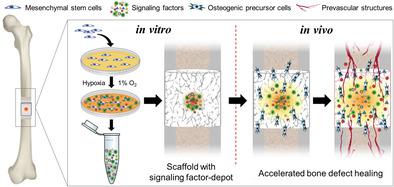当前位置:
X-MOL 学术
›
Adv. Healthcare Mater.
›
论文详情
Our official English website, www.x-mol.net, welcomes your feedback! (Note: you will need to create a separate account there.)
The Secretome of Hypoxia Conditioned hMSC Loaded in a Central Depot Induces Chemotaxis and Angiogenesis in a Biomimetic Mineralized Collagen Bone Replacement Material.
Advanced Healthcare Materials ( IF 10.0 ) Pub Date : 2019-12-12 , DOI: 10.1002/adhm.201901426 Mandy Quade 1 , Pina Münch 1 , Anja Lode 1 , Sarah Duin 1 , Corina Vater 1, 2 , Anastasia Gabrielyan 3 , Angela Rösen-Wolff 3 , Michael Gelinsky 1
Advanced Healthcare Materials ( IF 10.0 ) Pub Date : 2019-12-12 , DOI: 10.1002/adhm.201901426 Mandy Quade 1 , Pina Münch 1 , Anja Lode 1 , Sarah Duin 1 , Corina Vater 1, 2 , Anastasia Gabrielyan 3 , Angela Rösen-Wolff 3 , Michael Gelinsky 1
Affiliation

|
The development of biomaterials with intrinsic potential to stimulate endogenous tissue regeneration at the site of injury is a main demand on future implants in regenerative medicine. For critical-sized bone defects, an in situ tissue engineering concept is devised based on biomimetic mineralized collagen scaffolds. These scaffolds are functionalized with a central depot loaded with a signaling factor cocktail, obtained from secretome of hypoxia-conditioned human mesenchymal stem cells (MSC). Therefore, hypoxia-conditioned medium (HCM)-production is standardized and adapted to achieve high signaling factor-yields; a concentration protocol based on dialysis and freeze-drying is established to enable the integration of sufficient and defined amounts into the depot. In humid milieu-as after implantation-signaling factors are released by forming a chemotactic gradient, inducing a directed migration of human bone marrow stroma cells (hBMSC) into the scaffold. Angiogenic potential, determined by coculturing human umbilical vein endothelial cells (HUVEC) with osteogenically induced hBMSC shows prevascular structures, which sprout throughout the interconnected pores in a HCM-concentration-dependent manner. Retarded release by alginate-based (1 vol%) depots, significantly improves sprouting-depth and morphology of tubular structures. With the intrinsic potential to supply attracted cells with oxygen and nutrients, this bioactive material system has great potential for clinical translation.
中文翻译:

缺氧条件hMSC的秘密组加载在中央仓库中诱导趋化性和血管生成的仿生矿化的胶原蛋白骨替代材料中。
具有潜在潜力在损伤部位刺激内源性组织再生的生物材料的开发是对再生医学未来植入物的主要需求。对于临界尺寸的骨缺损,基于仿生矿化胶原蛋白支架设计了原位组织工程概念。这些支架由装载了信号因子混合物的中央仓库功能化,该混合物从缺氧条件下的人间充质干细胞(MSC)的分泌组中获得。因此,对低氧条件培养基(HCM)的生产进行了标准化,并已实现了高信号因子产量。建立了基于透析和冷冻干燥的浓缩方案,以将足够的和确定的量整合到储库中。在潮湿的环境中(如植入后),通过形成趋化梯度释放信号因子,从而诱导人骨髓基质细胞(hBMSC)定向迁移至支架。通过将人脐静脉内皮细胞(HUVEC)与成骨诱导的hBMSC共同培养而确定的血管生成潜力显示出血管前结构,该结构以HCM浓度依赖的方式在整个相互连接的孔中发芽。藻酸盐基(1%(体积))贮库的缓释作用,显着改善了管状结构的发芽深度和形态。具有向被吸引的细胞提供氧气和营养的内在潜力,这种生物活性材料系统具有巨大的临床翻译潜力。通过将人脐静脉内皮细胞(HUVEC)与成骨诱导的hBMSC共同培养而确定的血管生成潜力显示出血管前结构,该结构以HCM浓度依赖性方式在整个相互连接的孔中发芽。藻酸盐基(1%(体积))贮库的缓释作用,显着改善了管状结构的发芽深度和形态。具有向被吸引的细胞提供氧气和营养的内在潜力,这种生物活性材料系统具有巨大的临床翻译潜力。通过将人脐静脉内皮细胞(HUVEC)与成骨诱导的hBMSC共同培养而确定的血管生成潜力显示出血管前结构,该结构以HCM浓度依赖的方式在整个相互连接的孔中发芽。藻酸盐基(1%(体积))贮库的缓释作用,显着改善了管状结构的发芽深度和形态。具有向被吸引的细胞提供氧气和营养的内在潜力,这种生物活性材料系统具有巨大的临床翻译潜力。显着改善了管状结构的发芽深度和形态。具有向被吸引的细胞提供氧气和营养的内在潜力,这种生物活性材料系统具有巨大的临床翻译潜力。显着改善了管状结构的发芽深度和形态。具有向被吸引的细胞提供氧气和营养的内在潜力,这种生物活性材料系统具有巨大的临床翻译潜力。
更新日期:2020-01-23
中文翻译:

缺氧条件hMSC的秘密组加载在中央仓库中诱导趋化性和血管生成的仿生矿化的胶原蛋白骨替代材料中。
具有潜在潜力在损伤部位刺激内源性组织再生的生物材料的开发是对再生医学未来植入物的主要需求。对于临界尺寸的骨缺损,基于仿生矿化胶原蛋白支架设计了原位组织工程概念。这些支架由装载了信号因子混合物的中央仓库功能化,该混合物从缺氧条件下的人间充质干细胞(MSC)的分泌组中获得。因此,对低氧条件培养基(HCM)的生产进行了标准化,并已实现了高信号因子产量。建立了基于透析和冷冻干燥的浓缩方案,以将足够的和确定的量整合到储库中。在潮湿的环境中(如植入后),通过形成趋化梯度释放信号因子,从而诱导人骨髓基质细胞(hBMSC)定向迁移至支架。通过将人脐静脉内皮细胞(HUVEC)与成骨诱导的hBMSC共同培养而确定的血管生成潜力显示出血管前结构,该结构以HCM浓度依赖的方式在整个相互连接的孔中发芽。藻酸盐基(1%(体积))贮库的缓释作用,显着改善了管状结构的发芽深度和形态。具有向被吸引的细胞提供氧气和营养的内在潜力,这种生物活性材料系统具有巨大的临床翻译潜力。通过将人脐静脉内皮细胞(HUVEC)与成骨诱导的hBMSC共同培养而确定的血管生成潜力显示出血管前结构,该结构以HCM浓度依赖性方式在整个相互连接的孔中发芽。藻酸盐基(1%(体积))贮库的缓释作用,显着改善了管状结构的发芽深度和形态。具有向被吸引的细胞提供氧气和营养的内在潜力,这种生物活性材料系统具有巨大的临床翻译潜力。通过将人脐静脉内皮细胞(HUVEC)与成骨诱导的hBMSC共同培养而确定的血管生成潜力显示出血管前结构,该结构以HCM浓度依赖的方式在整个相互连接的孔中发芽。藻酸盐基(1%(体积))贮库的缓释作用,显着改善了管状结构的发芽深度和形态。具有向被吸引的细胞提供氧气和营养的内在潜力,这种生物活性材料系统具有巨大的临床翻译潜力。显着改善了管状结构的发芽深度和形态。具有向被吸引的细胞提供氧气和营养的内在潜力,这种生物活性材料系统具有巨大的临床翻译潜力。显着改善了管状结构的发芽深度和形态。具有向被吸引的细胞提供氧气和营养的内在潜力,这种生物活性材料系统具有巨大的临床翻译潜力。

























 京公网安备 11010802027423号
京公网安备 11010802027423号